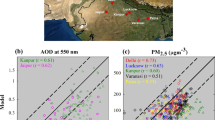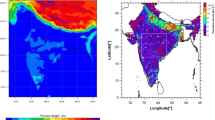Abstract
In Northeast Asia, the effect of long-range transport of air pollutants is generally pronounced in spring and winter, but can be important even in summer. This study analyzed summer-time atmospheric transport of elemental carbon (EC) and sulfate (SO4 2−) with the Community Multiscale Air Quality (CMAQ) model driven by the Weather Research and Forecasting (WRF) model. The WRF/CMAQ modeling system was applied to regions ranging from Northeast Asia to the Greater Tokyo Area in Japan in summer 2007. In terms of EC, while the model simulated well the effect of long-range transport, the simulation results indicated that domestic emissions in Japan dominantly contributed (85%) to EC concentrations in the Greater Tokyo. In terms of SO4 2−, the simulation results indicated that both domestic emissions (62%) and long-range transport from the other countries (38%) substantially contributed to SO4 2− concentrations in the Greater Tokyo. Distinctive transport processes of SO4 2− were associated with typical summer-time meteorological conditions in the study region. When a Pacific high-pressure system covered the main island of Japan, domestic emissions, including volcanic emission, dominantly contributed to SO4 2− concentrations in the Greater Tokyo. When a high-pressure system prevailed over the East China Sea and low-pressure systems passed north of Japan, synoptic westerly winds associated with this pressure pattern transported a large amount of SO4 2− from the continent to Japan. In addition, although heavy precipitation and strong wind decreased SO4 2− concentrations near the center of a typhoon, peripheral typhoon winds occasionally played an important role in long-range transport of SO4 2−.
Similar content being viewed by others
References
Aikawa, M., T. Ohara, T. Hiraki, O. Oishi, A. Tsuji, M. Yamagami, K. Murano, and H. Mukai, 2010: Significant geographic gradients in particulate sulfate over Japan determined from multiple-site measurements and a chemical transport model: Impacts of transboundary pollution from the Asian continent. Atmos. Environ., 44, 381–391.
Andres, R. J., and A. D. Kasgnoc, 1998: A time-averaged inventory of subaerial volcanic sulfur emissions. J. Geophys. Res., 103, 25251–25261.
Badarinath, K. V. S., S. K. Kharol, A.R. Sharma, V. Ramaswamy, D. G. Kaskaoutis, and H. D. Kambezidis, 2009: Investigations of an intense aerosol loading during 2007 cyclone SIDR — A study using satellite data and ground measurements over Indian region. Atmos. Environ., 43, 3708–3716.
Bond, T.C., D. G. Streets, K. F. Yarber, S. M. Nelson, J.-H. Woo, and Z. Klimont, 2004: A technology-based global inventory of black and organic carbon emissions from combustion. J. Geophys. Res., 109, D14203, doi:10.1029/2003JD003697.
Byun, D. W., and K. L. Schere, 2006: Review of the governing equations, computational algorithms, and other components of the Models-3 Community Multiscale Air Quality (CMAQ) modelling system. Appl. Mech. Rev., 59, 51–77.
Carmichael, G. R., and Coauthors, 2002: The MICS-Asia study: Model intercomparison of long-range transport and sulfur deposition in East Asia. Atmos. Environ., 36, 175–199.
Carter, W. P. L., 2000: Documentation of the SAPRC-99 chemical mechanism for VOC reactivity assessment. Final Report to California Air Resources Board Contract No. 92-329 and (in part) 95-308.
Chang, J. S., R. A. Brost, I. S. A. Isaksen, S. Madronich, P. Middleton, W. R. Stockwell, and C. J. Walcek, 1987: A Three-Dimensional Eulerian Acid Deposition Model: Physical Concepts and Formulation. J. Geophys. Res., 92, 14681–14700.
Chang, L. T.-C., J.-H. Tsai, J.-M. Lin, Y.-S. Huang, and H.-L. Chiang, 2011: Particulate matter and gaseous pollutants during a tropical storm and air pollution episode in Southern Taiwan. Atmos. Res., 99, 67–79.
Chatani, S., T. Morikawa, S. Nakatsuka, S. Matsunaga, and H. Minoura, 2011: Development of a framework for a high-resolution, three-dimensional regional air quality simulation and its application to predicting future air quality over Japan. Atmos. Environ., 45, 1383–1393.
____, and Coauthors, 2013: Multi-model analyses of dominant factors influencing elemental carbon in Tokyo Metropolitan Area of Japan, Aerosol Air Qual. Res., submitted.
Chen, F. and J. Dudhia, 2001: Coupling an advanced land-surface/hydrology model with the Penn State/NCAR MM5 modeling system — Part I: Model implementation and sensitivity. Mon. Wea. Rev., 129, 569–585.
Draxler, R. R., and G. D. Hess, 1997: Description of the Hysplit_4 modeling system. NOAA Tech. Memo. ERL ARL-224.
Dudhia, J., 1989: Numerical study of convection observed during the Winter Monsoon Experiment using a mesoscale two-dimensional model. J. Atmos. Sci., 46, 3077–3107.
Emery, C., E. Tai, and G. Yarwood, 2001: Enhanced meteorological modeling and performance evaluation for two Texas ozone episodes. Prepared for The Texas Natural Resource Conservation Commission 12118 Park 35 Circle Austin, Texas 78753.
Emmons, L. K., and Coauthors, 2010: Description and evaluation of the Model for Ozone and Related chemical Tracers, version 4 (MOZART-4). Geosci. Model Dev., 3, 43–67.
Feng, Y., A. Wang, D. Wu, and X. Xu, 2007: The influence of tropical cyclone Melor on PM10 concentrations during an aerosol episode over the Pearl River Delta region of China: Numerical modeling versus observational analysis. Atmos. Environ., 41, 4349–4365.
Guenther, A., T. Karl, P. Harley, C. Wiedinmyer, P. I. Palmer, and C. Geron, 2006: Estimates of global terrestrial isoprene emissions using MEGAN (Model of Emissions of Gases and Aerosols from Nature). Atmos. Chem. Phys., 6, 3181–3210.
Hallquist, M., and Coauthors, 2009: The formation, properties and impact of secondary organic aerosol: Current and emerging issues. Atmos. Chem. Phys., 9, 5155–5236.
Hong, S.-Y. and J.-O. J. Lim, 2006: The WRF Single-Moment 6-Class Microphysics Scheme (WSM6). J. Korean Meteor. Soc., 42, 129–151.
Janjic, Z. I., 2002: Nonsingular Implementation of the Mellor-Yamada Level 2.5 Scheme in the NCEP Meso model. NCEP Office Note, No. 437, 61 pp.
Japan Petroleum Energy Center, cited 2010: JATOP: Japan Auto-Oil Program. [Available online at http://www.pecj.or.jp/english/jcap/jatop/index_jatop.html.]
JMA, cited 2007: Monthly Volcanic Activity Report. [Available online at http://www.seisvol.kishou.go.jp/tokyo/STOCK/monthly_v-act_doc/monthly_vact_2007.htm.] (in Japanese).
Kain, J. S., 2004: The Kain-Fritsch convective parameterization. An update. J. Appl. Meteorol., 43, 170–181.
Kannari, A., Y. Tonooka, T. Baba, and K. Murano, 2007: Development of multiple-species 1 km × 1 km resolution hourly basis emissions inventory for Japan. Atmos. Environ., 41, 3428–3439.
Ka**o, M., H. Ueda, H. Satsumabayashi, and J. An, 2004: Impacts of the eruption of Miyakejima Volcano on air quality over far east Asia. J. Geophys. Res., 109, D21204, doi:10.1029/2004JD004762.
Lee, S.-H., Y.-K. Kim, H.-S. Kim, and H.-W. Lee, 2007: Influence of dense surface meteorological data assimilation on the prediction accuracy of ozone pollution in the southeastern coastal area of the Korean Peninsula. Atmos. Environ., 41, 4451–4465.
Lin, M., T. Holloway, G. R. Carmichael, and A. M. Fiore, 2010: Quantifying pollution inflow and outflow over East Asia in spring with regional and global models. Atmos. Chem. Phys., 10, 4221–4239.
Minoura, H., K. Takahashi, J. C. Chow, and J. G. Watson, 2006: Multi-year trend in fine and coarse particle mass, carbon, and ions in downtown Tokyo, Japan. Atmos. Environ., 40, 2478–2487.
Mlawer, E. J., S. J. Taubman, P. D. Brown, M. J. Iacono, and S. A. Clough, 1997: Radiative transfer for inhomogeneous atmospheres: RRTM, a validated correlated-k model for the longwave. J. Geophys. Res., 102, 16663–16682.
Murano, K., 2006: International Co-operative Survey to Clarify the Transboundary Air Pollution Across the Northern Hemisphere (Abstract of the Final Report), Summary Report of Research Results under the GERF (Global Environment Research Fund) in FY2004, 237–243, Research and Information Office, Global Environment Bureau, Ministry of the Environment, Government of Japan.
Nansai, K., N. Suzuki, K. Tanabe, S. Kobayashi, and Y. Moriguchi, 2004: Design of Georeference-Based Emission Activity Modeling System (GBEAMS) for Japanese emission inventory management. Proc., the 13th International Emission Inventory Conference in Clearwater, Florida, United States of America.
Nawahda, A., K. Yamashita, T. Ohara, J. Kurokawa, and K. Yamaji, 2012: Evaluation of premature mortality caused by exposure to PM2.5 and ozone in East Asia: 2000, 2005, 2020. Water, Air Soil Pollut., 223, 3445–3459.
Neupane, B., M. Jerrett, R. T. Burnett, T. Marrie, A. Arain, and M. Loeb, 2010: Long-term exposure to ambient air pollution and risk of hospitalization with community-acquired pneumonia in older adults. Am. J. Resp. Crit. Care, 181, 47–53.
NIES, 2009: Forecast and impact analysis of fine particles and photochemical pollutants in urban air environment, Report of Special Research from the National Institute for Environmental Studies, Japan, SR-91-2009. (in Japanese).
Ohara, T., H. Akimoto, J. Kurokawa, N. Horii, K. Yamaji, X. Yan, and T. Hayasaka, 2007: An Asian emission inventory of anthropogenic emission sources for the period 1980–2020. Atmos. Chem. Phys., 7, 4419–4444.
Pleim, J. E., and J. S. Chang, 1992: A Non-Local Closure Model for Vertical Mixing in the Convective Boundary Layer. Atmos. Environ., 26A, 965–981, 1992.
Pirovano, G., and Coauthors, 2012: Investigating impacts of chemistry and transport model formulation on model performance at European scale. Atmos. Environ., 53, 93–109.
Shimadera, H., A. Kondo, A. Kaga, K. L. Shrestha, and Y. Inoue, 2009: Contribution of transboundary air pollution to ionic concentrations in fog in the Kinki Region of Japan. Atmos. Environ., 43, 5894–5907.
____, _____, K. L. Shrestha, A. Kaga, and Y. Inoue, 2011: Annual sulfur deposition through fog, wet and dry deposition in the Kinki Region of Japan. Atmos. Environ., 45, 6299–6308.
Skamarock, W. C., J. B. Klemp, J. Dudhia, D. O. Gill, D. M. Baker, M. G. Duda, X.-Y. Huang, W. Wang, and J. G. Powers, 2008: A description of the advanced research WRF version 3. NCAR Tech. Note, NCAR/TN-475+STR.
Streets, D. G., K. F. Yarber, J.-H. Woo, and G. R. Carmichael, 2003: Biomass burning in Asia: Annual and seasonal estimates and atmospheric emissions. Global Biogeochem. Cycles, 17, 10/1–10/20.
Ueda, K., H. Nitta, M. Ono, and A. Takeuchi, 2009: Estimating mortality effects of fine particulate matter in Japan: A comparison of time-series and case-crossover analyses. J. Air Waste Manage. Assoc., 59, 1212–1218.
Willmott, C. J., 1981: On the validation of models. Phys. Geogr., 2, 184–194.
Zhang, M., I. Uno, Y. Yoshida, Y. Xu, Z. Wang, H. Akimoto, T. Bates, T. Quinn, A. Bandy, and B. Blomquist, 2004: Transport and transformation of sulfur compounds over East Asia during the TRACE-P and ACE-Asia campaigns. Atmos. Environ., 38, 6947–6959.
Zhang, Q., and Coauthors, 2009: Asian emissions in 2006 for the NASA INTEX-B mission. Atmos. Chem. Phys., 9, 5131–5153.
Author information
Authors and Affiliations
Corresponding author
Rights and permissions
About this article
Cite this article
Shimadera, H., Hayami, H., Morino, Y. et al. Analysis of summertime atmospheric transport of fine particulate matter in Northeast Asia. Asia-Pacific J Atmos Sci 49, 347–360 (2013). https://doi.org/10.1007/s13143-013-0033-y
Received:
Revised:
Accepted:
Published:
Issue Date:
DOI: https://doi.org/10.1007/s13143-013-0033-y




